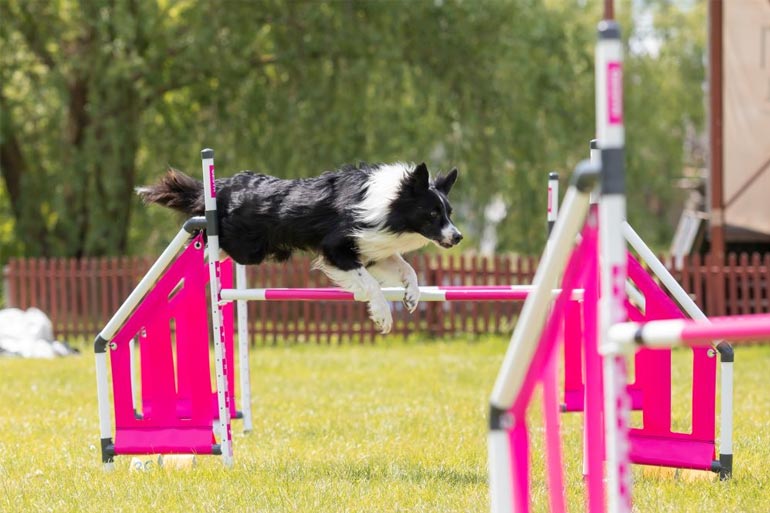
Agility jumps are the most common obstacle on any agility obstacle course. At Carlson Agility, we offer a huge selection of competition-quality agility jumps for dogs, but first let’s discuss some facts and training tips for using these pieces of dog agility equipment.
The Dog Agility Course: Some Basic Facts
Dog agility, as we know it today, has its roots in the United Kingdom and can be traced back to the late 1970s. It was first introduced as entertainment for spectators at the Crufts Dog Show in 1978. John Varley, a committee member, is credited with the idea of creating a competition that would be similar to equestrian show jumping but designed for dogs.
The initial idea was to create an event that was engaging for the audience while also providing a fun way to demonstrate dogs’ natural speed and agility. It quickly gained popularity and soon became a competitive sport in its own right. The rules and equipment have been refined over time, with safety for dogs as a priority. Best of all, dogs of all sizes and breeds (including mixed breeds) typically are allowed to participate.
Agility tests the handler’s control and connection with their dog as they guide them through a course filled with various obstacles, including jumps, tunnels, a dog agility teeter and weave poles just to name a few. Today, dog agility is a popular sport worldwide, with many formal international competitions and numerous local clubs encouraging participation at all levels.
Many dog obstacles mimic the natural instinctual behavior of dogs. For instance, as they soar over dog jumps, this is much like jumping over brooks or logs in the pursuit of prey. Moving through a tunnel might be an imitation of a dog scurrying under a pile of leaves to sniff out a squirrel or another smaller creature.
Learning The Jumps: 10 Quick Tips For Success
The typical agility course will include a pause table, a dog agility a-frame, a dog walk, dog agility teeter-totter, a dog agility tunnel, weaves, a tire jump and several other types of jumps. Most agility organizations also offer competitions that focus almost entirely on jumping, so it’s crucial to nail this skill. Here are a few tips that will help your dog find success with jumps.
1. Start Slowly
Introduce your dog to the concept of agility jumping slowly. You can start by just allowing them to sniff and explore the jump. This helps your dog feel comfortable with the new equipment.
2. Keep Heights Low At First
Initially, set the bar at the lowest height or even on the ground, so your dog can easily step or hop over it. Gradually increase the height as your dog gains confidence and ability.
3. Use Rewards
Always have treats or toys on hand to reward your dog immediately when they do the right thing. This will motivate them and reinforce positive behavior. Eventually, your dog will need to be able to traverse an entire course without treats, but they can be great motivators in the early stages of training.
4. Lead By Example
In the beginning, you might need to step or jump over the bar first to show your dog what to do. Again, it’s perfectly fine to start the process by simply resting the pole on the ground. You can wait and add height after your dog learns to jump over a pole on the ground.
5. Use A Leash
Start with a leash to guide your dog over the jump. Be sure not to pull or force them. The leash is just for gentle guidance.
6. Be Patient
Don’t rush your dog. Let them progress at their own pace to prevent them from feeling scared or overwhelmed.
7. Short Training Sessions
Keep training sessions short and fun. This can prevent your dog from becoming too tired or losing interest. This is good advice when using any piece of agility training equipment.
8. Consistency is Key
Regular training is important. Even 10-15 minutes a day can help your dog learn faster. Be sure to always use the same agility commands and cues every time to ensure that the dog fully understands when it’s time to jump and which direction they should go after the jump.
9. Add More Agility Jumps
Once your dog has mastered one jump, gradually add more to your backyard to mimic an agility course. Eventually, you will want to add items such as double jumps, triple jumps and the agility tire jump.
10. Safety First
Ensure the agility equipment is safe and suitable for your dog’s size and age. Always check the equipment for any potential hazards before each training session. Also, ensure your dog is in good health and consult your vet before starting any new vigorous training routines. We do not recommend using agility jumps or most pieces of agility equipment until your dog is fully grown.
In general, many of these tips can be used to teach just about any piece of dog agility equipment. Keeping training sessions short, ensuring safety and using plenty of praise and a reward or two can make training go much more smoothly.
Remember to stay patient. After all, this is meant to be a fun activity to share with your precious pooch and whether or not you ever compete, it will strengthen your bond and provide you and your dog with a fantastic form of exercise.
Get Started Now With Dog Agility!
Dog agility is a fantastic, fun sport that just about any energetic, healthy dog will enjoy. At Carlson Agility, we can provide you with agility jumps for dogs as well as any other type of dog agility equipment you might need, including some handy training tools. All of our items are handmade using the highest quality components and all of the pieces are competition quality, so if you do decide to compete, you will be using the same obstacles that you will find on most agility courses.





